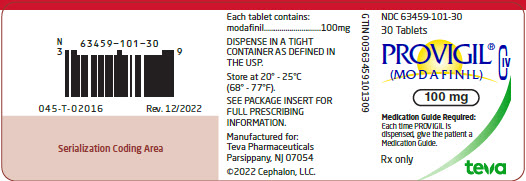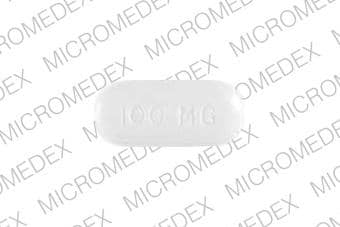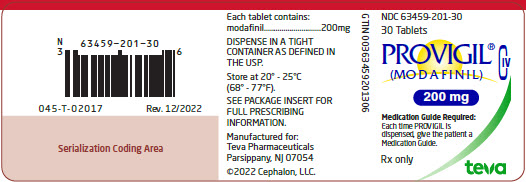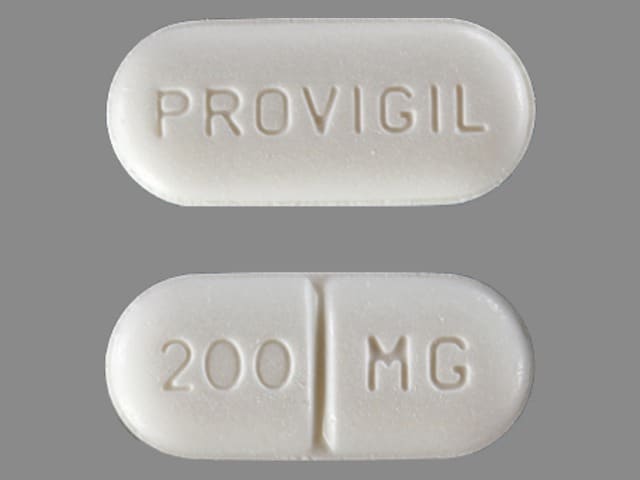Provigil
Generic name: modafinil
Drug class: CNS stimulants
Medically reviewed by A Ras MD.
What is Provigil?
Provigil is a prescription medicine used to improve wakefulness in adults who are very sleepy due to one of the following diagnosed sleep disorders narcolepsy, obstructive sleep apnea (OSA). Provigil is used to treat excessive sleepiness, but not the obstruction or medical condition that is causing OSA. You should talk with your doctor about treatments for OSA before you start taking Provigil and during treatment with Provigil. Provigil does not take the place of treatments that your doctor has prescribed for OSA.
Provigil will not cure these sleep disorders. Provigil may help the sleepiness caused by these conditions, but it may not stop all your sleepiness. Provigil does not take the place of getting enough sleep. Follow your doctor’s advice about good sleep habits and using other treatments.
Provigil is a federally controlled substance (C-IV) because it can be abused or lead to dependence. Keep Provigil in a safe place to prevent misuse and abuse. Selling or giving away Provigil may harm others, and is against the law. Tell your doctor if you have ever abused or been dependent on alcohol, prescription medicines, or street drugs.
Description
PROVIGIL (modafinil) is a wakefulness‑promoting agent for oral administration. Modafinil is a racemic compound. The chemical name for modafinil is 2‑[(diphenylmethyl)sulfinyl]acetamide. The molecular formula is C15H15NO2S and the molecular weight is 273.35.
The chemical structure is:

Modafinil is a white to off-white, crystalline powder that is practically insoluble in water and cyclohexane. It is sparingly to slightly soluble in methanol and acetone.
PROVIGIL tablets contain 100 mg or 200 mg of modafinil and the following inactive ingredients: croscarmellose sodium, lactose monohydrate, magnesium stearate, microcrystalline cellulose, povidone, and pregelatinized starch.
Mechanism of Action
The mechanism(s) through which modafinil promotes wakefulness is unknown. Modafinil has wake-promoting actions similar to sympathomimetic agents including amphetamine and methylphenidate, although the pharmacologic profile is not identical to that of the sympathomimetic amines.
Modafinil-induced wakefulness can be attenuated by the α1-adrenergic receptor antagonist, prazosin; however, modafinil is inactive in other in vitro assay systems known to be responsive to α-adrenergic agonists such as the rat vas deferens preparation.
Modafinil is not a direct- or indirect-acting dopamine receptor agonist. However, in vitro, modafinil binds to the dopamine transporter and inhibits dopamine reuptake. This activity has been associated in vivo with increased extracellular dopamine levels in some brain regions of animals. In genetically engineered mice lacking the dopamine transporter (DAT), modafinil lacked wake-promoting activity, suggesting that this activity was DAT-dependent. However, the wake-promoting effects of modafinil, unlike those of amphetamine, were not antagonized by the dopamine receptor antagonist haloperidol in rats. In addition, alpha-methyl-p-tyrosine, a dopamine synthesis inhibitor, blocks the action of amphetamine, but does not block locomotor activity induced by modafinil.
In the cat, equal wakefulness-promoting doses of methylphenidate and amphetamine increased neuronal activation throughout the brain. Modafinil at an equivalent wakefulness-promoting dose selectively and prominently increased neuronal activation in more discrete regions of the brain. The relationship of this finding in cats to the effects of modafinil in humans is unknown.
In addition to its wake-promoting effects and ability to increase locomotor activity in animals, modafinil produces psychoactive and euphoric effects, alterations in mood, perception, thinking, and feelings typical of other CNS stimulants in humans. Modafinil has reinforcing properties, as evidenced by its self-administration in monkeys previously trained to self-administer cocaine; modafinil was also partially discriminated as stimulant-like.
The optical enantiomers of modafinil have similar pharmacological actions in animals. Two major metabolites of modafinil, modafinil acid and modafinil sulfone, do not appear to contribute to the CNS-activating properties of modafinil.
What is the most important information I should know about Provigil?
Provigil may cause serious side effects including a serious rash or a serious allergic reaction that may affect parts of your body such as your liver or blood cells. Any of these may need to be treated in a hospital and may be life-threatening.
Stop taking Provigil and call your doctor right away or get emergency help if you have any of these symptoms:
- skin rash, hives, sores in your mouth, or your skin blisters and peels
- swelling of your face, eyes, lips, tongue, or throat
- trouble swallowing or breathing
- fever, shortness of breath, swelling of the legs, yellowing of the skin or whites of the eyes, or dark urine
If you have a severe rash with Provigil, stopping the medicine may not keep the rash from becoming life-threatening or causing you to be permanently disabled or disfigured.
Provigil is not approved for use in children for any medical condition.
It is not known if Provigil is safe or effective in children under 17 years of age.
Who should not take Provigil?
Do not take Provigil if you:
- are allergic or developed a rash to modafinil or armodafinil (Nuvigil) or any of the ingredients in Provigil. See the end of this Medication Guide for a complete list of ingredients in Provigil.
What should I tell my healthcare provider before taking Provigil?
Tell your doctor about all of your medical conditions including, if you:
- have a history of mental health problems, including psychosis
- have heart problems or had a heart attack
- have high blood pressure. Your blood pressure may need to be checked more often while taking Provigil.
- have liver or kidney problems
- have a history of drug or alcohol abuse or addiction
- are pregnant or planning to become pregnant. It is not known if Provigil will harm your unborn baby.
- Pregnancy Registry: There is a registry for women who become pregnant during treatment with Provigil. The purpose of this registry is to collect information about the safety of Provigil during pregnancy. Contact the registry as soon as you learn that you are pregnant, or ask your doctor to contact the registry for you. You or your doctor can get information and enroll you in the registry by calling 1-866-404-4106.
- are breastfeeding. It is not known if Provigil passes into your breast milk. Talk to your doctor about the best way to feed your baby if you take Provigil.
Tell your doctor about all the medicines you take, including prescription and over-the-counter medicines, vitamins, and herbal supplements. Provigil and many other medicines can interact with each other, sometimes causing side effects. Provigil may affect the way other medicines work, and other medicines may affect how Provigil works. Your dose of Provigil or certain other medicines may need to be changed.
Especially, tell your doctor if you use or take:
- a hormonal birth control method, such as birth control pills, shots, implants, patches, vaginal rings, and intrauterine devices (IUDs). Hormonal birth control methods may not work while you take Provigil. Women who use one of these methods of birth control may have a higher chance for getting pregnant while taking Provigil, and for one month after stopping Provigil. Talk to your doctor about birth control choices that are right for you while taking Provigil.
Know the medicines you take. Keep a list of them and show it to your doctor and pharmacist when you get a new medicine. Your doctor or pharmacist will tell you if it is safe to take Provigil and other medicines together. Do not start any new medicines with Provigil unless your doctor has told you it is okay.
How should I take Provigil?
- Take Provigil exactly as prescribed by your doctor. Your doctor will prescribe the dose of Provigil that is right for you. Do not change your dose of Provigil without talking to your doctor.
- Your doctor will tell you the right time of day to take Provigil.
- People with narcolepsy or OSA usually take Provigil 1 time each day in the morning.
- People with SWD usually take Provigil about 1 hour before their work shift.
- Do not change the time of day you take Provigil unless you have talked to your doctor. If you take Provigil too close to your bedtime, you may find it harder to go to sleep.
- You can take Provigil with or without food.
- If you take more than your prescribed dose or if you take an overdose of Provigil, call your doctor or go to the nearest hospital emergency room right away.
Symptoms of an overdose of Provigil may include:
- trouble sleeping
- restlessness
- confusion
- feeling disoriented
- feeling excited
- hearing, seeing, feeling, or sensing things that are not really there (hallucinations)
- nausea and diarrhea
- a fast or slow heartbeat
- chest pain
- increased blood pressure
What should I avoid while taking Provigil?
- Do not drive a car or do other dangerous activities until you know how Provigil affects you. People with sleep disorders should always be careful about doing things that could be dangerous. Do not change your daily habits until your doctor tells you it is okay.
- You should avoid drinking alcohol. It is not known how drinking alcohol will affect you when taking Provigil.
What are possible side effects of Provigil?
Provigil may cause serious side effects. Stop taking Provigil and call your doctor right away or get emergency help if you get any of the following:
- a serious rash or serious allergic reaction. (See “What is the most important information I should know about Provigil?”)
- Mental (psychiatric) symptoms, including:
- depression
- feeling anxious
- hearing, seeing, feeling, or sensing things that are not really there (hallucinations)
- an extreme increase in activity and talking (mania)
- thoughts of suicide
- aggressive behavior
- other mental problems
- Symptoms of a heart problem, including chest pain, abnormal heartbeat, and trouble breathing.
Common side effects that can happen in anyone who takes Provigil include:
- headache
- diarrhea
- back pain
- feeling anxious
- nausea
- trouble sleeping
- feeling nervous
- dizziness
- stuffy nose
- upset stomach
Provigil is not approved for use in children for any medical condition including Attention Deficit Hyperactivity Disorder (ADHD). In studies of Provigil in children with narcolepsy, side effects included:
- Tourette’s syndrome
- hostile behavior
- increase in sudden loss of muscle tone and severe muscle weakness
- increase in seeing and hearing things when falling asleep
- increase in suicidal thoughts
- low white blood count
- painful menstrual periods
Tell your doctor if you get any side effect that bothers you or that does not go away while taking Provigil.
These are not all the side effects of Provigil. For more information, ask your doctor or pharmacist.
Some effects of Provigil on the brain are the same as other medicines called “stimulants”. These effects may lead to abuse or dependence on Provigil.
Call your doctor for medical advice about side effects. You may report side effects to FDA at 1-800-FDA-1088.
General information about the safe and effective use of Provigil
Medicines are sometimes prescribed for purposes other than those listed in a Medication Guide. Do not use Provigil for a condition for which it was not prescribed. Do not give Provigil to other people, even if they have the same symptoms you have. It may harm them and it is against the law.
This Medication Guide summarizes the most important information about Provigil. If you would like more information, talk with your doctor. You can ask your doctor or pharmacist for information about Provigil that is written for health professionals. For more information, call 1-888-483-8279.
How should I store Provigil?
- Store Provigil at room temperature between 68° and 77° F (20° and 25° C).
- Keep Provigil and all medicines out of the reach of children.
What are the ingredients in Provigil?
Active Ingredient: modafinil
Inactive Ingredients: lactose monohydrate, microcrystalline cellulose, pregelatinized starch, croscarmellose sodium, povidone, and magnesium stearate.
Label
PACKAGE/LABEL DISPLAY PANEL
NDC 63459-101-30
30 Tablets
PROVIGIL® (MODAFINIL) CIV 100 mg
Medication Guide Required: Each time PROVIGIL is dispensed, give the patient a Medication Guide.
Rx only
teva


PACKAGE/LABEL DISPLAY PANEL
- NDC 63459-201-30
30 Tablets
PROVIGIL® (MODAFINIL) CIV 200 mg
Medication Guide Required: Each time PROVIGIL is dispensed, give the patient a Medication Guide.
Rx only
teva


SRC: NLM .
